Existing User Log In
New User Registration
Register for a free account to gain full access to the VGChartz Network and join our thriving community.



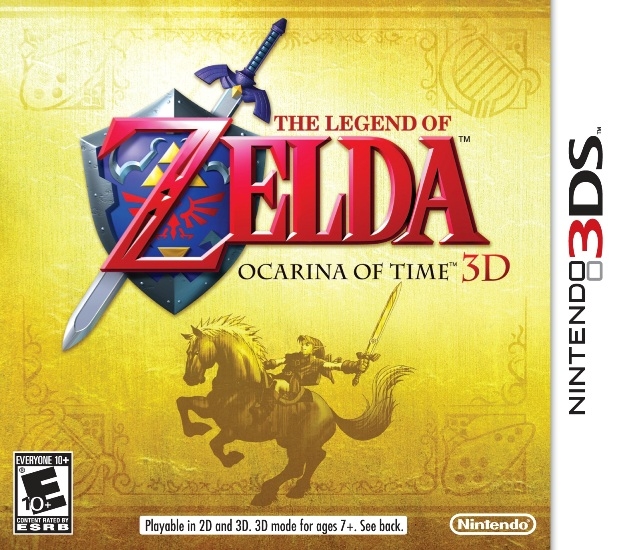

America - Front


America - Back

What do you get when you take one of the most beloved Nintendo games of all time, upgrade the graphics, toss in new content and control mechanics, and slap it on a portable? Super Mario 64 DS, you say? Well... ok, you got me.
The original Super Mario 64 was the game that, to many, showed off the benefits of running around a 3D game world. The possibilities for immersion in gaming were raised exponentially, and the potential gameplay applications were unfathomable.
Unfathomable, that is, until Zelda. The Legend of Zelda: Ocarina of Time took the design sensibilities of previous games in the series—the overworld, the dungeons, the puzzles, the ease of control, the character interaction—and transferred them into a polygonal environment so rich and detailed that many still consider it the finest game ever crafted. Thirteen years later, Nintendo is attempting to sell us on another kind of 3D technology: stereoscopic. With this in mind, an updated Ocarina on the 3DS isn’t just a good idea; it is easily the finest title released on the platform to date.
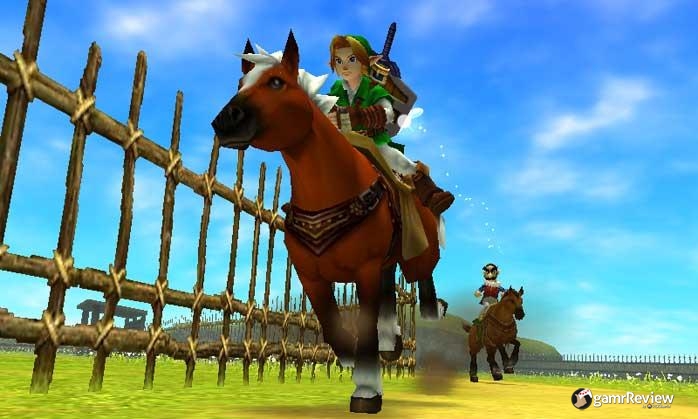
Ah... I'm home.
First, the burning question: What’s changed in The Legend of Zelda: Ocarina of Time 3D? Simultaneously, ‘not much’ and ‘a lot’. Nintendo and co-developer Grezzo have taken great care to preserve the magical experience of the original game while updating it to take advantage of new hardware, as well as a few minor tweaks here and there.
For those who haven’t played the original game (for shame!), the basic premise is that you’re a boy named Link who lives in the forest with his tribe of elf-like people called the Kokiri. Unlike all of his friends, Link was never given a fairy that follows him for life, so he is always picked on by most other kids in the village. That all changes when he is summoned by the Great Deku Tree, which watches over all life in the forest. After procuring a sword, a shield, and a fairy and breaking the tree of an evil curse, it tells him about the Triforce, a magical object whose bearer has unimaginable Power, Courage, and Wisdom. Dark forces are attempting to procure the Triforce, and so the most logical solution is to send a young boy who’s never left his forest to stop them. So, Link embarks on an epic quest involving the fair Princess Zelda, the evil Ganondorf, and a magic ocarina that can, among other things, send him back and forth through time.
That was the basic summary for the original game, and nothing’s changed here. The Zelda formula has remained constant throughout the series—you go through a dungeon, solve some puzzles, get a new item to help you solve more puzzles, fight a boss, talk to some characters, get the sacred object you’re looking for, and repeat. Veterans won’t find anything new or changed in the way of dungeon layouts, object placements, character development, or story. So, if you played the original, you’ll instantly know your way around Kokiri Village, Hyrule Castle Town, and of course, the much-maligned Water Temple.
What has changed is that the game’s graphics have been updated to modern standards for new hardware, while still being true to the vision of the original game. With the added polygons, Link’s character model looks less abstract and more in line with the concept art that went along with the original game. Textures are at a much higher resolution, and objects that should be round actually are this time, but the ‘mystical’ feeling that always pervaded Hyrule remains. This is all aided by the near-silky-smooth framerate, which makes the game world flow much better than it did on the N64. However, hills, some buildings, and certain other key structures do look a little blocky still, and the action still slows down once in a while when there are lots of enemies and breakable objects being destroyed at once. All in all, though, the game looks stunning.
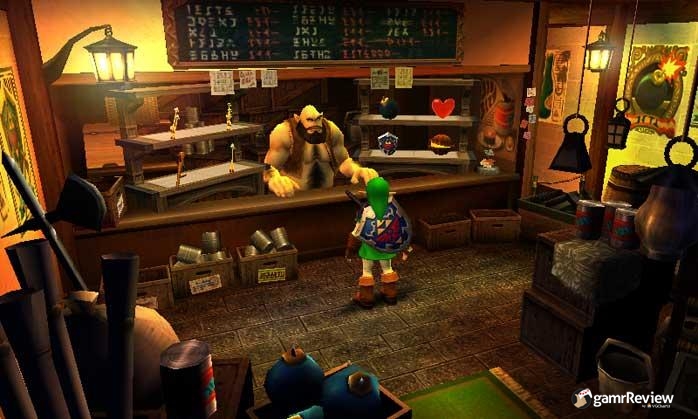
As opposed to 2D images, shop backgrounds are now fully rendered.
Said mystical feeling is magnified by the 3D. If there was ever a poster-child for the tech in the 3DS’ top screen, this is it. There is a great sense of depth in this game world—when you fall from a high height, there is a palpable sense of vertigo as the inevitable pain rushes toward you. Rain in certain cutscenes made me instinctively blink as it jumped out of the screen, as if I was going to get splashed in the face. Of course, the basic thrill of dashing around Hyrule Field on your steed, Epona, is magnified when you can see her and Link dashing far off into the distance.
Aside from the graphics, most other additions and changes are more of the ‘subtle’ variety. As opposed to the original game, where you had to pause, scroll over to a required item, assign it to a button, then unpause, inventory use in Ocarina 3D is much more streamlined. Simply tap ‘Items’ or ‘Gear’ on the lower screen, tap the item, then assign it to a button. You have one more ‘quick item’ slot in this game than the original’s three, as you can assign things to the ‘X’ and ‘Y’ buttons, as well as two virtual buttons on the touch-screen. In an appreciated touch, the ocarina (one of the most-used items in the game) doesn’t take up one of the slots, instead occupying its own permanent space in the lower-left of the touch-screen. You can also view the notes to your songs while holding the instrument now, eliminating even more of the original’s annoying menu hopping. The 3DS’ motion-sensing capabilities are put to good use, too. Any item that sends you into first-person mode, like the slingshot, boomerang, or hookshot, can now be aimed either with the Circle Pad or by physically moving the system around. I found the former to be much quicker and more fun, using the latter only for finer adjustments.
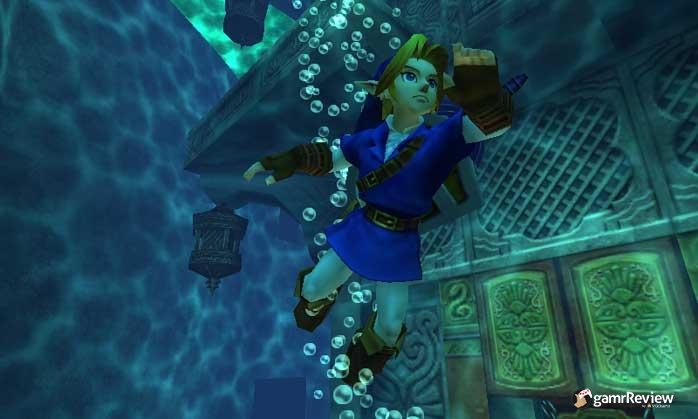
Hello, Water Temple, my old frienemy.
Content-wise, the only real addition to the package is the ability to replay any bosses you’ve defeated. By sleeping in Link’s bed in Kokiri Village, you can relive your fights against Queen Gohma, King Dodongo, Dark Link, and all of the others. If you beat them all again by this method, you unlock ‘Boss Rush’ mode, in which you can attempt to beat all of them in a single life—a worthy challenge, to be sure, but nothing worth buying the game over. Also included is The Legend of Zelda: Ocarina of Time Master Quest, a bonus first included in the GameCube port of the original N64 game. This is essentially ‘Hard mode.’ Master Quest is the same game, but the world has been flipped horizontally, and dungeon layouts and puzzles have been changed to be significantly more challenging. Master Quest benefits from the same graphical updates and other tweaks as the main game.
Unfortunately, for as many enhancements as have been made to the game, some core features that could have done with an update were either left as-is or made worse. There hasn’t been much of an update from an aural perspective, for instance. While Link’s yelps and sword swipes come in clearer this time, and the tunes are still great, the audio is still in a computer-generated MIDI format. This was understandable in 1998, as this file type doesn’t take up much space and the game was limited to a 32-megabyte Nintendo 64 cartridge. The 3DS’ cartridges are a gigabyte, at the minimum, and with the fantastic graphical update, the decade-plus-old sound sticks out like a bombed dodongo. It would have sounded amazing if all of the ocarina’s songs were recorded on an actual ocarina. Hearing Epona’s Song in all its fully-orchestrated glory would have brought a tear to my eye.
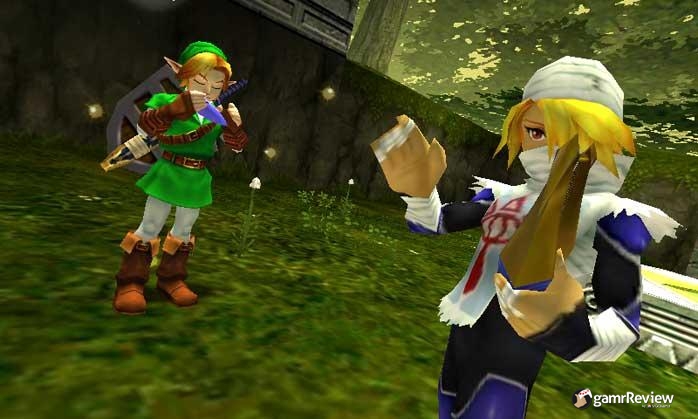
You look very... *puts on sunglasses*... Shiek. (YEEEEEAAH!)
In addition, there’s Navi the fairy. To anyone who’s ever played the original, I don’t think I need to say more. Honestly, I think Link should have been ecstatic that he was the only one without a fairy, as she still yells ‘Hey! Listen!’ every thirty seconds. If you actually do press her touch-screen button to listen, she either has something completely irrelevant to say, or she’s saying you must go to Kakariko Village when you’re already in Kakariko Village. In fact, she’s even worse in this version of the game. Once in a while, she’ll offer you a hint movie that shows little snippets of what you need to do. Now, I haven’t had as much issue with that one as other critics, as the first time I was presented with a video was over halfway through the game. What did annoy me even more was that, if I was in the middle of a lengthy play session, I would pause the action to see what she had to say, only to have her tell me I should take a break. I can't stand when a game tells you to stop playing itself.
If you’re concerned about how much bang you get for your buck here, let me break it down. If you haven’t played it before, the main game can easily take at least forty hours to beat, and even then you’ll likely still have a fair amount of sidequests to complete. There are dozens of Gold Skulltulas to find and defeat, and you get some nifty prizes for killing milestone numbers of them. You can become a travelling mask salesman, go for the top prize in all manner of minigames, and scour the world for every last life-extending Piece of Heart. Boss Rush mode will probably add another couple of hours. Then there’s Master Quest, which will take you at least as long again. All told, I can easily see new players getting a hundred hours out of this package.
The Legend of Zelda: Ocarina of Time 3D is the first game that I honestly feel justifies owning a 3DS. The system has some other great titles, but Zelda is the first to really hammer home just how much the capabilities of this new system can add to a game. Beautiful graphics, effective motion control, and touch-screen use that eliminates a lot of monotony, all layered on top of an already top-of-the-class game. Even if you’ve already beaten it ten times, I would still recommend Ocarina 3D because it is easily the definitive version of the game. Despite a few issues like the odd framerate hitch and music quality that should have been upgraded, this game has done the improbable and exemplified the benefits that a 3D world can bring to video gaming—twice.










|
|
|
|
|
garretslarrity
posted 01/07/2019, 02:17
Reported the error. Hopefully this gets deleted soon. Message | Report |
|
|
|
|
|
|
|
|
|